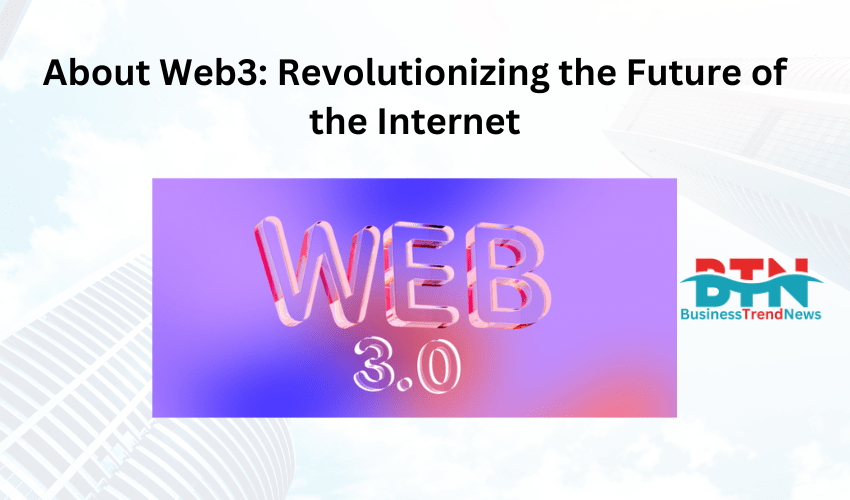![]()
About Web3: Revolutionizing the Future of the Internet
Introduction
The internet has undergone significant transformations over the years, evolving from Web1 (a read-only, static web) to Web2 (the interactive, user-driven web), and now to Web3, which promises decentralization, user control, and a revolutionary approach to data, services, and interactions. This evolution represents a shift in how data, privacy, and ownership are handled online, focusing on empowering users and removing centralized intermediaries.
In this article, we will explore Web3, its defining technologies, its impact on various sectors, and what it means for the future of the internet.
Evolution of the Web: From Web1 to Web3
Web1: The Early Internet (1990s)
Web1 was the earliest phase of the internet, starting in the 1990s. During this era, the internet was primarily a collection of static, read-only websites where users could consume information but had limited interaction. Websites were non-dynamic, offering little engagement beyond basic browsing and hyperlink navigation.
Web1 could be compared to an online encyclopedia, where users only accessed information but didn’t have the ability to generate their own content or interact with others on platforms.
Web2: The Social and Interactive Web (2000s)
The rise of Web2 in the early 2000s brought the internet to life. This version of the web introduced social media platforms like Facebook, Twitter, and YouTube, giving users the power to create, share, and interact with content in real-time. Web2 democratized access to publishing and communication, fostering collaboration and community building.
However, with this power came centralized control. Tech giants like Google, Amazon, and Facebook consolidated user data, leading to concerns about privacy, data ownership, and monopolies. Users began questioning the control and influence these corporations had over their personal information.
Web3: The Decentralized Future
Web3 is the next major evolution, bringing decentralization to the forefront of the digital experience. In Web3, control is no longer concentrated in the hands of a few companies. Instead, it shifts to individuals and communities through technologies like blockchain, decentralized applications (dApps), and cryptocurrencies.
Web3 emphasizes user ownership, privacy, and security. It operates on peer-to-peer networks and blockchain technologies that eliminate the need for intermediaries like banks, social networks, or even hosting services. This decentralization has far-reaching implications for the internet’s future, transforming industries from finance to entertainment.
Key Technologies Driving Web3
- Blockchain At the heart of Web3 is blockchain, a decentralized, transparent, and immutable ledger. Blockchain is the technology that powers cryptocurrencies, decentralized applications, and smart contracts.
- Public Blockchains like Ethereum allow anyone to participate in the network, facilitating decentralized applications and services.
- Smart Contracts are self-executing contracts with the terms of the agreement written into code. These contracts automatically execute actions when predefined conditions are met, removing the need for intermediaries.
- Cryptocurrencies Cryptocurrencies are digital or virtual currencies that use blockchain technology to ensure secure, decentralized transactions. In Web3, cryptocurrencies serve as the primary medium of exchange, allowing for decentralized finance (DeFi) and other economic systems to flourish.
- Bitcoin is the first and most well-known cryptocurrency, but others like Ether (Ethereum) have also gained widespread use, particularly for enabling decentralized applications.
- Stablecoins, like USDC or DAI, aim to reduce the volatility typically associated with cryptocurrencies, providing more stable value for transactions.
- Decentralized Applications (dApps) dApps are software applications that run on decentralized networks, particularly blockchain. Unlike traditional applications hosted on central servers, dApps run on a distributed blockchain, making them resistant to censorship and control.
dApps can be used for various purposes, including finance, gaming, social media, and governance. Some prominent examples include:
- Uniswap (a decentralized exchange for trading cryptocurrencies),
- Aave (a decentralized lending protocol),
- Axie Infinity (a blockchain-based game using NFTs).
- Decentralized Finance (DeFi) DeFi is one of the most promising use cases of Web3, aiming to recreate and improve upon traditional financial systems by using blockchain technology. DeFi platforms allow users to lend, borrow, trade, and earn interest on cryptocurrencies without relying on traditional financial intermediaries like banks.
- Decentralized exchanges (DEXs), like Uniswap and PancakeSwap, facilitate peer-to-peer trading without the need for centralized exchanges.
- Yield farming and staking allow users to earn rewards by providing liquidity or staking tokens in DeFi protocols, generating returns that often surpass those of traditional banking systems.
- Non-Fungible Tokens (NFTs) NFTs are unique digital assets that represent ownership or proof of authenticity for digital or physical items, such as art, music, or virtual real estate. NFTs have opened up new opportunities for creators to monetize their work and for users to own digital assets with provable scarcity.
- The NFT market has seen exponential growth, with platforms like OpenSea and Rarible allowing users to buy, sell, and trade NFTs.
- Decentralized Autonomous Organizations (DAOs) DAOs are organizations that operate without centralized leadership. They are governed by smart contracts and decisions are made democratically by token holders. DAOs enable collective decision-making, funding allocation, and governance in a decentralized and transparent manner.
- Examples of DAOs include MakerDAO, which governs the DAI stablecoin, and ConstitutionDAO, which attempted to purchase a rare copy of the U.S. Constitution.
Benefits of Web3
- User Ownership and Control Web3 gives users control over their data and digital assets. In Web3, users can own their digital identities and control how their information is shared or used. This contrasts sharply with Web2, where companies like Facebook or Google own and profit from user data.
- Decentralization and Security By eliminating central intermediaries, Web3 offers a higher level of security and resilience. Data stored on a blockchain is distributed across thousands of nodes, making it nearly impossible for a single entity to alter or hack it. This decentralization also protects against censorship.
- Transparency The blockchain’s public nature ensures that transactions and activities are fully transparent. Every transaction is recorded and can be verified by anyone, promoting accountability and reducing fraud.
- Monetization and Incentives Web3 introduces new models for monetizing content and services, such as token-based economies. Creators can be paid directly by their audiences using cryptocurrencies, and users can earn tokens for contributing to decentralized networks or applications.
Web3’s Impact on Industries
- Finance Web3 is already revolutionizing the financial sector through DeFi. Traditional banking systems are being replaced by decentralized financial services that are more accessible, efficient, and inclusive. Users can now borrow, lend, trade, and invest without the need for a bank.
- Art and Entertainment The rise of NFTs has transformed the creative industries. Artists, musicians, and content creators can now mint NFTs and sell their work directly to their audience, cutting out intermediaries and capturing more value.
- Social Media Web3 social media platforms prioritize user privacy and ownership of content. Unlike Web2 social networks, which profit from user data, Web3 platforms allow users to control and monetize their interactions. Decentralized platforms like Mastodon or Steemit are already experimenting with these models.
- Gaming Blockchain-based games, such as Axie Infinity and Decentraland, integrate cryptocurrency rewards and NFTs, allowing players to earn real-world value through gameplay. This play-to-earn model has disrupted the traditional gaming industry, where only game developers profited.
- Governance DAOs are transforming governance models by enabling decentralized decision-making. DAOs allow communities to govern their projects collectively, using blockchain-based voting systems that ensure transparency and fairness.
Challenges and Criticisms of Web3
Despite its promise, Web3 faces several challenges:
- Scalability: Current blockchain networks often struggle with scalability, limiting the number of transactions they can handle. Solutions like Ethereum 2.0 and layer 2 scaling solutions aim to address this issue.
- Energy Consumption: Blockchain networks, especially those using proof-of-work consensus algorithms, consume significant amounts of energy. Transitioning to more energy-efficient systems like proof-of-stake can mitigate this problem.
- Regulation: As Web3 continues to grow, it faces increasing scrutiny from governments and regulators. Navigating the evolving regulatory landscape will be essential for Web3’s long-term success.
Conclusion
Web3 represents a paradigm shift in how we interact with the internet, placing control back into the hands of users through decentralized networks, applications, and services. It promises a future where individuals can own their digital identities, control their data, and participate in decentralized economies. While challenges remain, the potential of Web3 to disrupt industries and empower users is enormous.
As Web3 continues to develop, it will redefine the internet, pushing it toward a more secure, transparent, and user-centered future.



